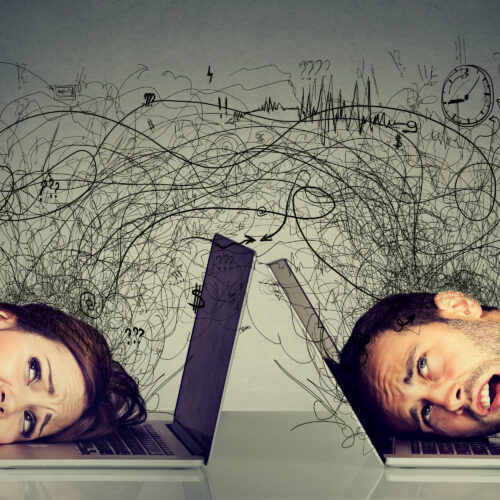
OCA wellbeing: On self-care
Creative learning in an online world
Wellbeing and care are important. Physical encounters with people are reduced, physical encounters with spaces are reduced. In current pandemic times we live a life that bounds us more and more at home. To get social, to get together means to go online through a virtual screen-based encounter with a digital Self and Other. What was before a welcoming experience to stay connected with fellow distant learners (see Fig. 1) became the norm for engagement and interaction in pandemic times. Is this now a daily routine for the better? Who knows whether some changing habits are sustained – even after current pandemic.
We are captured by our screens for its social interaction and for its instant gratification. It gives us direct and constant connectivity. The screen gives us stimuli that we are learned to adapt and to pay attention to. According some stats, the online and video presence of the population increased by more than 250% from March until May 2020 (MacKay, 2020). We have now more access than ever to global events, shows, webinars, virtual talks etc.
Some aspects of working online from home are important for self-care – in order not to be overwhelmed by online fatigue.

What is the challenge?
Not only to manage one’s online time effectively, or to ensure low level of disruptions especially at home. A challenge is also our rapid changing and adapting habits and bodily attitudes when moving from a workplace to a homeplace. At times our workplaces are designed for ergonomics (chair, height and size of screen, light conditions etc.). At home we don’t have it, we sit or lie wherever it feels comfortable. We use mostly small screen devices (laptop, tablet, phone) to get connected online. What may result in stress with visual symptoms (eyestrain, blurry vision, dry eyes) and somatic symptoms (headaches, neck, shoulder, and back pain). A screen fatigue and exhaustion that demands our self-care and care of those we love. The forthcoming publication ‘Tech Stress’ (Peper et al., 2020) describes mitigating strategies.
What is going wrong?
Possible reactions of our body to increased and overuse of screen-time:
- A continuous arousal by the screen
- Low level muscle tension, especially in the forearms, shoulder, back
- Irregular breathing pattern and blood flow
- Increasing attention load (we stop blinking, staring), we can’t get into a deep thought mood, but stay alert throughout the time, multitasking the screen, our notes, the surrounding space with distractions
- Losing facial expression and body movement (we do sit more)
- Resulting in major ‘sitting disease’
- Our posture collapses, slouching (bending forward)
- Impact on our affects, our emotions, our mood
- Last not least it can impact our cognition
Biofeedback measurements have shown that when one is relaxed with hands resting in the lap, breathing and muscle tension are normal. Typing or mousing, working with the hands in front of the computer impacts both, with increased muscle tension in forearm and shoulder resulting unconsciously in shallow breathing. Try it yourself: sit down with both feet on the ground – lift one foot (check after next paragraph)
How can we take Self-care?
Possible ideas to change maladaptive behaviours and helping to reduce physical strain and mental drain:
- Have a good and clean workplace at your disposal with a good chair
- Optimising ergonomics: getting a larger screen up with the right height (eye level when sitting straight) and distance from your eye, best to have a separate keyboard and mouse as well.
- Improving vision: looking out of the window, into the distance to relax the eye from constantly near distance focusing
- Getting up and moving around during the call, to change sitting and standing and walking
- Installing break programs, e.g. as done during OCA virtual making days, but as important for a one- or two-hour online session
- Keep your mobile phone away
- Switching-off video to avoid looking at the screen, to engage with audio only
- Changing: change habits as often as possible, communicate about these with your family, friends, and close ones
- Cultivating: Make it a habit to listen to your breathing and your body
Did you breathe normally when lifting your foot?
I would love to hear your experiences. Please share! Your ideas of living a healthy ‘online’ life might inspire others.
Reference
MacKay, J. (2020) Zoom burnout is sapping your energy and focus: How to avoid the fatigue
of too many video calls, At: https://blog.rescuetime.com/zoom-burnout/ (Accessed on 26 Jun 2020).
Peper, E., Harvey, R. and Faass, N. (2020) Tech Stress – How Technology is hijacking our lives,
strategies for coping, and pragmatic ergonomics. North Atlantic Books.
Featured image credit: Adobe Stock Photo #169190717 @pathdoc
Blog post by Stefan J Schaffeld – BA Fine Art pathway – level HE5
|
|







Lovely article…we are adaptable..but we need to recognize what happens within. It dawned on me that I occupy a range of virtual spaces due to the Pandemic, live in Dubai, study at OCA, London..spending lockdown on a farm un South Africa…need grounding practices more than ever!
Thanks, Karen from your personal experience . Yes, a nomad life of virtual presences, places do become virtual. Agree that grounding practices are crucial for being connected with life. We are adaptable, and we are partly malleable. But we are not like clay to be formed and eventually to break down
Very insightful article Stefan, thank you. We could all certainly benefit by building more positively disruptive physical activity into our day. We invested in a basketball hoop and basketballs to encourage play and creative movement between work calls. I’ve just raised my screen to eye level based on your practical tips!
Hi Susan, thanks for your feedback. Glad to hear how you adjusted ergonomics and embraced movement as part of creative learning. Hope the basketball hoop will get many good ball shots.
Hi Stefan, this was a really timely article for me. Although I’m only in the very early stages of studying I had started to feel quite unwell with the muscle tension and eye strain you mention. Last week I invested in a standing desk – it sits on top of the desk I use so I can work standing up. It may just be coincidence, but I really feel it’s helping already. Thanks for highlighting this.
Hi Teresa, thank you very much for sharing here your good experience with changing habits as self-care. Glad to hear it is supportive. Good continuation:-)